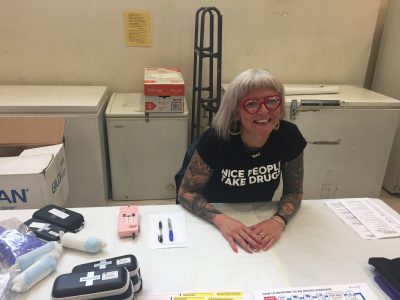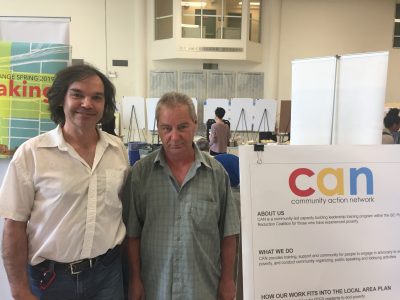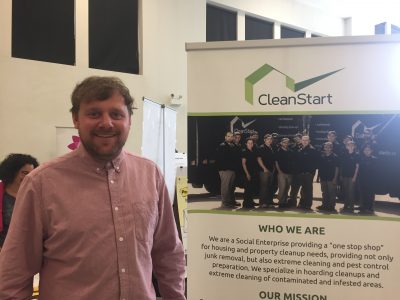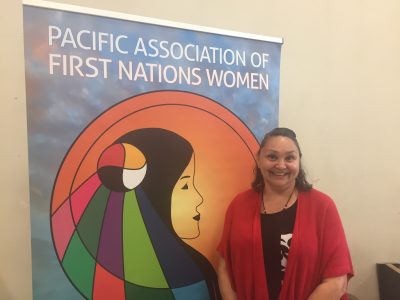Our Living City: The Downtown Eastside Community Fair
On June 20, 2019, Heritage Vancouver attended the Downtown Eastside Community Fair alongside dozens of other organizations that are active in the area. The DTES Community Fair is a platform for community members to take stock on the Downtown Eastside Plan, which is a 30-year vision for the neighbourhood that strives to ‘maintain the uniqueness of the DTES while revitalising the area without displacing residents’. The local area plan brought together various community groups, non-profit organizations, other levels of government, and City of Vancouver departments to have a conversation about priorities going forward.
We asked many of the community members present at the community fair a few questions about their relationship with the Downtown Eastside, what the neighbourhood means to them, and what they’d like the rest of the city to know about living and working there. Their responses can be found below.
Disclaimer: The views expressed below belong to those being interviewed and do not necessarily reflect the opinions of Heritage Vancouver.

All images were taken with consent of the photographed
Trish, The Downtown Community Health Centre
What’s your connection to the DTES?
 I work in the Downtown Eastside, I have been for two years. I love this community because I’ve noticed that a lot of people come to this community because it has created progress worldwide. It’s been really progressive. I find that if you look beyond the obvious things that people look for in this community, is that if you see how people take care of each other. It’s socially active and socially aware, like a family. You’ll notice all the resilience in this community, and that’s what I like about it here.
I work in the Downtown Eastside, I have been for two years. I love this community because I’ve noticed that a lot of people come to this community because it has created progress worldwide. It’s been really progressive. I find that if you look beyond the obvious things that people look for in this community, is that if you see how people take care of each other. It’s socially active and socially aware, like a family. You’ll notice all the resilience in this community, and that’s what I like about it here.
Can you explain a little bit more about what you mean by a world leading community?
It’s because of all of the research and education that’s this community has participated in, particularly around HIV, opiates, drug use, and harm reduction, among a lot of other things. It’s notorious around the world for producing leading research in harm reduction.
What is one story that you’ve picked up from living here that you’d like the rest of the world to know about the DTES?
I don’t have one particular story, but basically every day that I walk to work I notice high-fives, fist bumps, compliments. By the time I get to work, normally I’m floating on air because everyone is so gracious. I call it “compliment city” over here. I find it a really positive and vibrant community. Yes, there’s lots of problems that can be really sad. But I see a really vibrant and positive community. I think that we could all learn so much from these people, because they rule.
If you stop for a second to look beyond people injecting or whatever, you’ll notice that a dude is zipping his friends coat, someone else is looking after his friend who’s napping in the sun, someone else is helping people with their hair. So everyday when I walk down here I just think, “Jesus, this community rules”
Richard, Community Action Network
What’s your connection to the DTES?
 I come in from New Westminster, and I work with food resources. In New Westminster we have large free food resources. A lot of people come to us for meals. People come to the Downtown Eastside for meals, so when they come here we follow them here.
I come in from New Westminster, and I work with food resources. In New Westminster we have large free food resources. A lot of people come to us for meals. People come to the Downtown Eastside for meals, so when they come here we follow them here.
What is important about the Downtown Eastside to you?
For me it’s like a gathering place. I like to see Oppenheimer park to be a community place where people can share information, and not as just an escape from suffering.
What is one story that you’ve picked up from living here that you’d like the rest of the world to know about the DTES?
I’d say the people. In New West we call it ‘the circuit’, where people go around the different places to get food. Like say on Mondays one church offers lunch and breakfast, on Tuesdays another church has it, and so on. There’s a group of about fifty or so people in New West who go to all of them, and they all know each other. They know each other by their faces, by their name, and year after year they’re really part of our community.
Bill, Downtown Eastside resident
What’s your connection to the DTES?
I live here. Five years now.
What brought you here?
Homelessness. I ended up staying in a shelter in this area and then I found housing right around here.
What does this community mean to you?
A sense of community. I am working at a table here, and I know a lot of the other people at the other tables around me from community events. Community is definitely the most important thing. I’m actually glad that I ended up down here, even though it was a difficult situation.
What is one story that you’ve picked up from living here that you’d like the rest of the world to know about the DTES?
That’s a hard one. Once a lady asked me for a cigarette on Hastings, near Princess. I said “no sorry I can’t spare one.” She said “That’s okay, dear”. And that shows the kind of community and civility that I like about the Downtown Eastside.
Lelani, Downtown Eastside Neighbourhood House
What’s your connection to the DTES?
We work here. I also did my practicum at the Downtown Eastside Neighbourhood House. I felt very connected with it and I fell in love with the Neighbourhood House afterwards. It’s been just a few months.
What is important about the Downtown Eastside to you?
The DTES is one of the places in Vancouver that has a deep sense of community, and people tend to overlook it because they see it as a place with all sorts of social issues and so they dehumanize a lot of people in that space. I just really believe in the activism that continues to exist despite people’s struggles. It’s a very special space.
Before I did my practicum, I considered myself a compassionate and caring person, but even I had a certain view of the community. And so really getting in it was a huge eye-opener and inspiration to me. It’s actually the most real and authentic place that I’ve found in the city. As someone who’s moved here from out of province, I’ve really struggled with finding a sense of community. I looked for eight years, searching for it in the city, and it’s in the place where I might not have ever thought it was if I hadn’t spent the time here and talked to so many incredible and authentic people in the community.
What is one story that you’ve picked up from living here that you’d like the rest of the world to know about the DTES?
That’s a big question. I know someone who utilizes out services and contributes to so many spaces. I found out even today that he’s connected to nine organizations that are here in this space. He’s an amazing part of our community, he’s connected with the neighbourhood house, with harm reduction initiatives, with UBC learning exchange and indigenous business. He shows that people who live and work and play in the DTES are not in their own little bubble–they really think about the wider community and support other people and collaborate. I think it’s such a beautiful thing about the community and he represents so much of what happens down here. He’s just an awesome and incredible human being.
Kimit, Co-op Radio
What’s your connection to the DTES?
I work here, I live here, I play here. I currently work at Co-op Radio, which is right in the heart of it. I also often frequent venues in this area and attend shows here.
How long have you been living here?
I’ve been living in Vancouver at-large for about five years, but actually as of the last year I’ve been living in the Hastings Sunrise area.
What is important about the Downtown Eastside to you?
What’s important for me about the Downtown East side is that I feel like this is one place people from across cultural spheres and across social status can interact with each other in an honest way. I feel like this is one of the few places left in Vancouver where a lot of different cultural groups are allowed to hold space for what they’re doing. To me it’s important in a cultural sense, it’s important in a community sense, and it really is the future of Vancouver, as it seems to be the place that everyone has their eyes on.
What is one story that you’ve picked up from living here that you’d like the rest of the world to know about the DTES?
An experience I have every day is that while people may have this preconceived notion that the people who live here are ‘dangerous’ or that it’s an unsafe place to be, I’ve actually found it to be quite the opposite. When I get to work in the morning, almost every day someone will hold the door open for me when I bring my bike through the door. They’ll greet you, they’ll say hello. I think the one story I have every day concerns how friendly people are and how willing they are to interact with you, whereas in other areas I find that people either look right past you or don’t look at all.
Luke, CleanStart BC
What’s your connection to the DTES?
 My primary connection is through my job, but also as a resident of Vancouver there is a lot going on in the Downtown Eastside, so I also spend a bit of time here on a personal basis.
My primary connection is through my job, but also as a resident of Vancouver there is a lot going on in the Downtown Eastside, so I also spend a bit of time here on a personal basis.
Through my work, we employ people from the DTES and we primarily operate in the area.
How long have you been working here?
So I lived in Vancouver six years ago for about a year, but this time I’ve been working here since March.
What is important about the Downtown Eastside to you?
Just a sense of community. There’s a lot of obvious issues in the Downtown Eastside, but it’s an area where you see the the strength of community in the face of adversity. It’s that bond of community that I think makes is special.
What is one story that you’ve picked up from living here that you’d like the rest of the world to know about the DTES?
It’s not a positive one, but I think the world needs to know about the realities of the Downtown Eastside, because it’s right in the middle of one of the most expensive places to live in in Canada. But the property rates relative to income must be one of the worst in the world. At the same time you’ve got the poorest neighbourhood in the country. I think the world needs to know the reality and rather than gloss it over with positive stories. I can say that while working pest control, I’ve been into some of the SROs and I’ve seen the realities of the situations that people are living in. I think that if there rest of the city knew the seriousness of the situations and the environment of living in a hoarder’s suite, then people would be pushing for more money to be spent in the area, to provide better and cleaner housing. If I could send a message to the rest of the world, it would be to understand the seriousness of the situation here.
Lisa, BC Association of Community Response Neighbourhoods
What’s your connection to the DTES?
I live in the Downtown Eastside. I’m going on 21 years living here.
What is important about the Downtown Eastside to you?
I’d have to say it’s my indigenous association. I live just off of Commercial Drive, which has a strong Indigenous population, so I feel more comfortable living there than somewhere else in the city.
What is one story that you’ve picked up from living here that you’d like the rest of the world to know about the DTES?
I absolutely love the diversity out here. I tried to go and live in Southern Alberta and I didn’t realize how accustomed I am to the diversity of Vancouver. I am used to living in a non-English environment, but when I went to Alberta I found myself surrounded by just Dutch and German and I was quite shocked by my reaction to being in a non-English speaking environment that did not include Spanish, Punjabi, or all of the other diverse cultures that exist here in Vancouver. So that’s one thing that I really appreciate about being in Vancouver.
I also appreciate being environmentally friendly. I don’t even really think about other parts of BC as being as environmentally-friendly as Vancouver.
Stacey, Embers Eastside Works
What’s your connection to the DTES?
I’m not from here originally and I’ve moved around a lot, but in all the times that I’ve moved Vancouver has been my home. But the first time I walked through the Downtown Eastside I was 19, and I was really innocent and I was amazed to see people using right on the street. Then I left for a long time and came back, but in the time I was gone there was the onset of the opioid crisis and with everything going on I heard there was a high crime rate. And so I just wanted to establish for myself more of a home when I came back to Vancouver.
How long have you been working here?
I’d have to say it’s my indigenous association. I live just off of Commercial Drive, which has a strong Indigenous population, so I feel more comfortable living there than somewhere else in the city.
What is important about the Downtown Eastside to you?
The DTES to me was always kind of mysterious to me before. I knew it was very culturally rich in heritage. I knew there was lots of poverty, because you hear about that through the media. But since moving here, what I’ve found is that there’s really strong community. There are really diverse, wonderful, strong individuals here. There’s such a real sense of community in the middle of a city.
What is one story that you’ve picked up from living here that you’d like the rest of the world to know about the DTES?
I wouldn’t say there’s one story, but being able to celebrate people’s little victories with them. Because I’ve found that people can be really hard on themselves, myself included, and being able to show people even when I sometimes can’s show myself that they’re making positive changes in life and having successes.
We acknowledge the financial assistance of the Province of British Columbia.

